How does the velocity of a falling object change with time? How would you describe the mathematical relationship between velocity and time of a falling object? Explain the answer using your data, graphs, and the kinematic equations.The image below shows the ball stopping at 2 4 6 8 and 10 and how long it took it too stop there
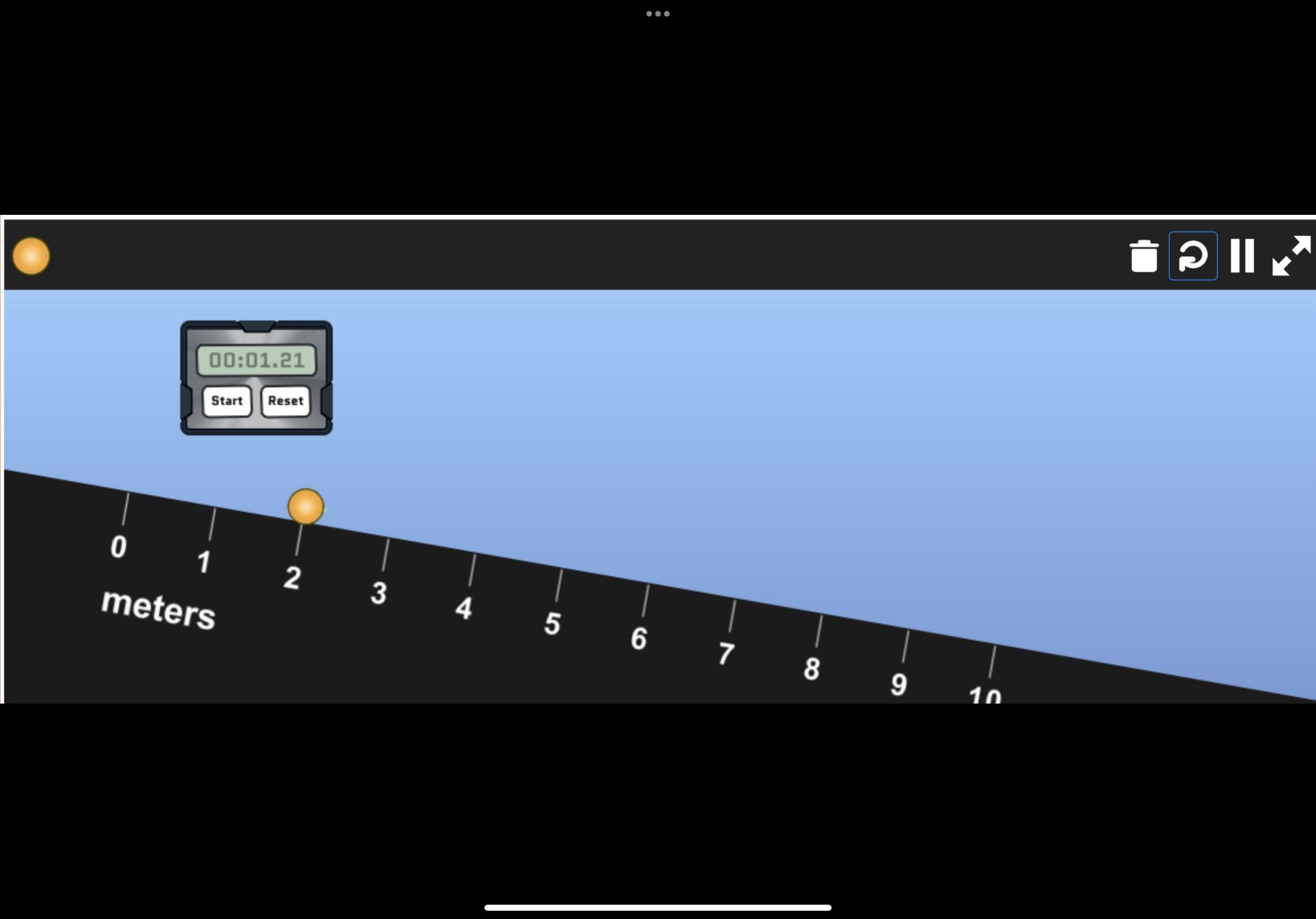
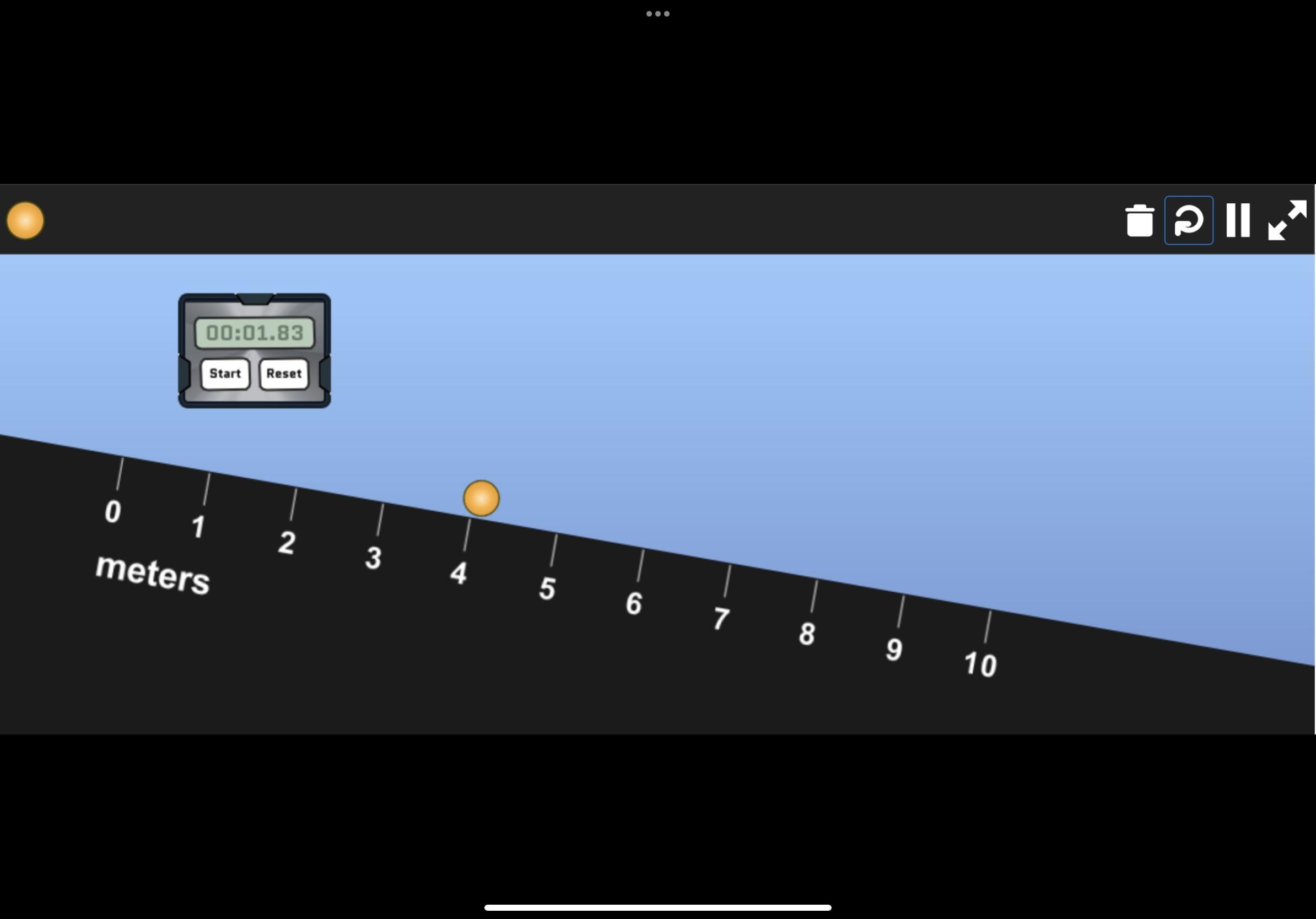
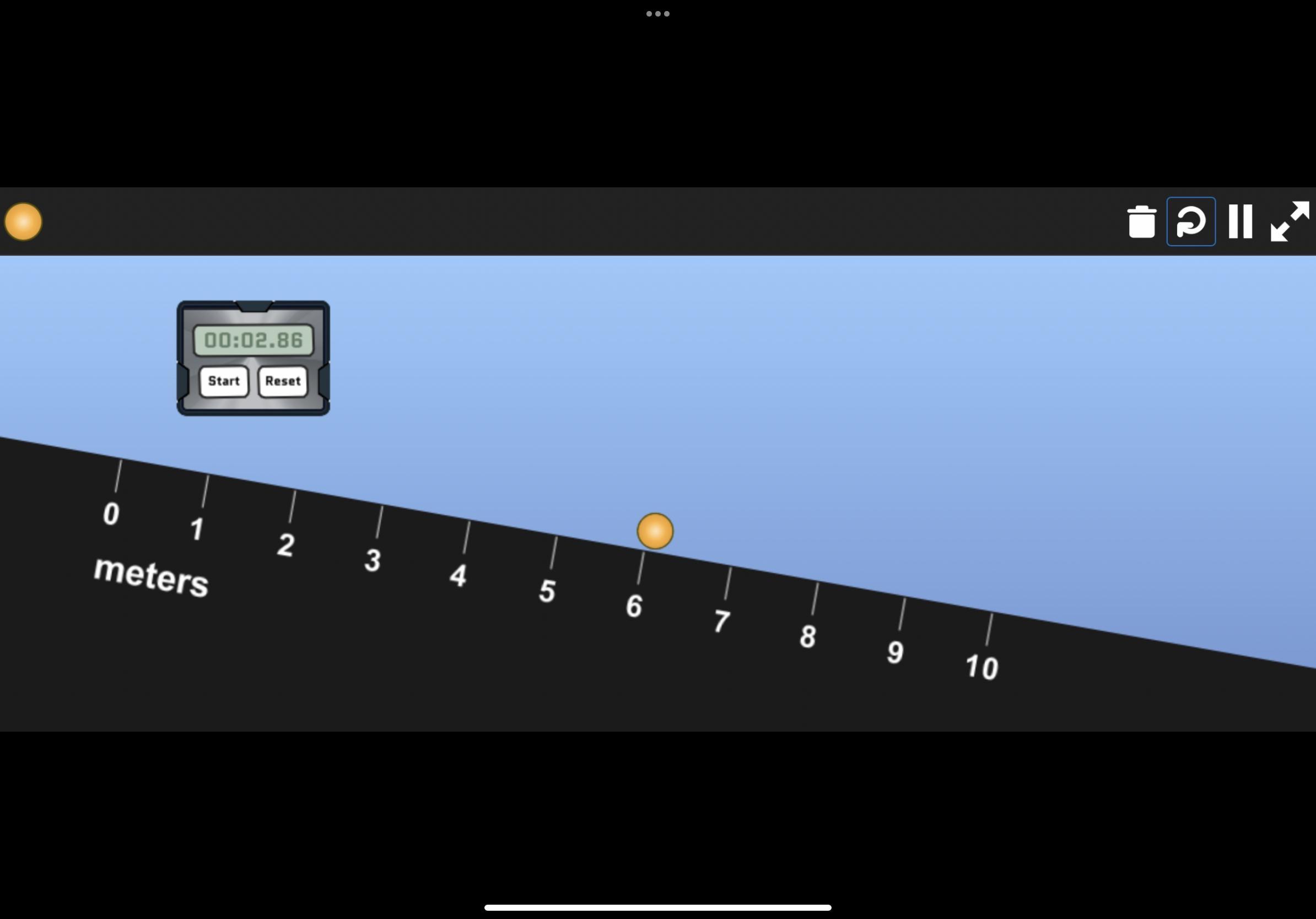
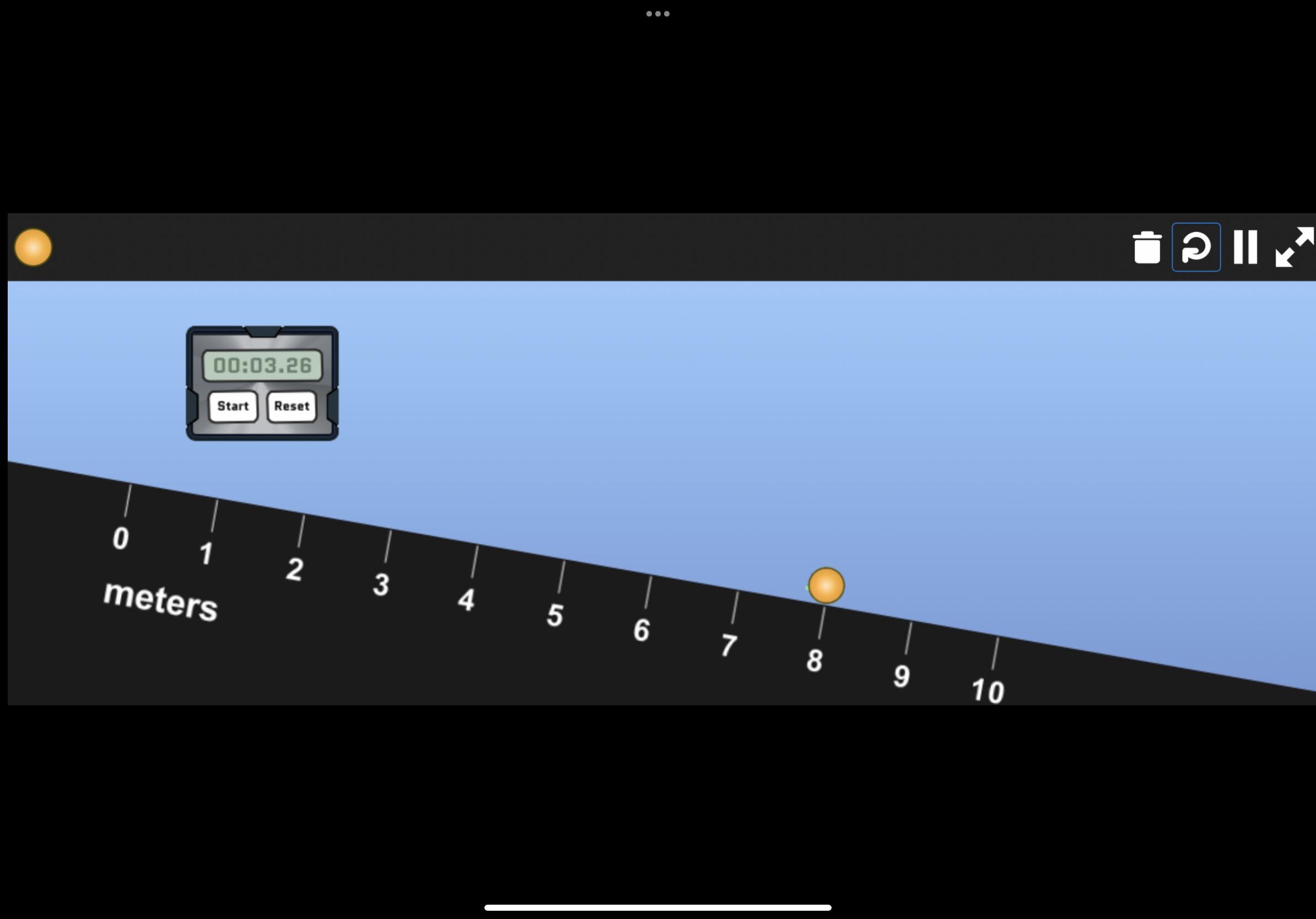
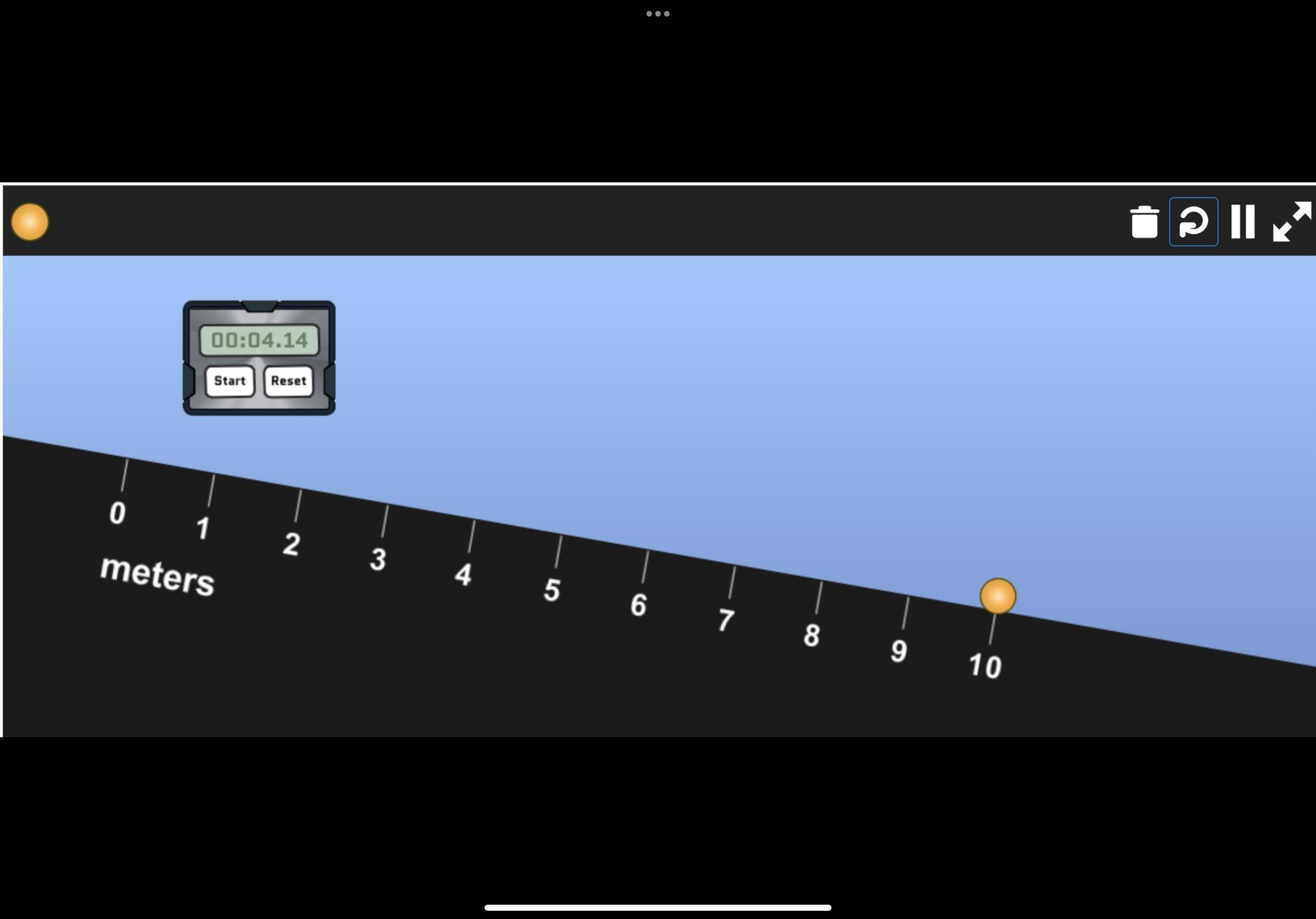
Answers
We will have the following:
First, we can see that the data presented is the following:
Now, from this information we can construct the following graphical relationship between time and distance drawn by the object:
From this we can infer that the relationship between time and distance is linear in nature, and the path of best descripton by linear regression is given by:
Where the approximation is:
[tex]f(x)=2.47204029x-0.4796893103[/tex]We can see the linear relationship that fits the model, from this and the fact that in kinematics the following is true:
[tex]d=v\ast t[/tex]Where "d" is the distace, "v" is the velocity and "t" the time.
From the data, the values of "x" represent the time and thus, the ratio of the function found is the velocity of the object.
In summary, the relationship is linear as per in kinematics, time and distace change proportionally in the data provided; and the approximated velocity of the object was 2.47m/s.
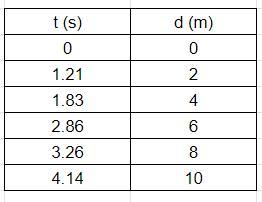

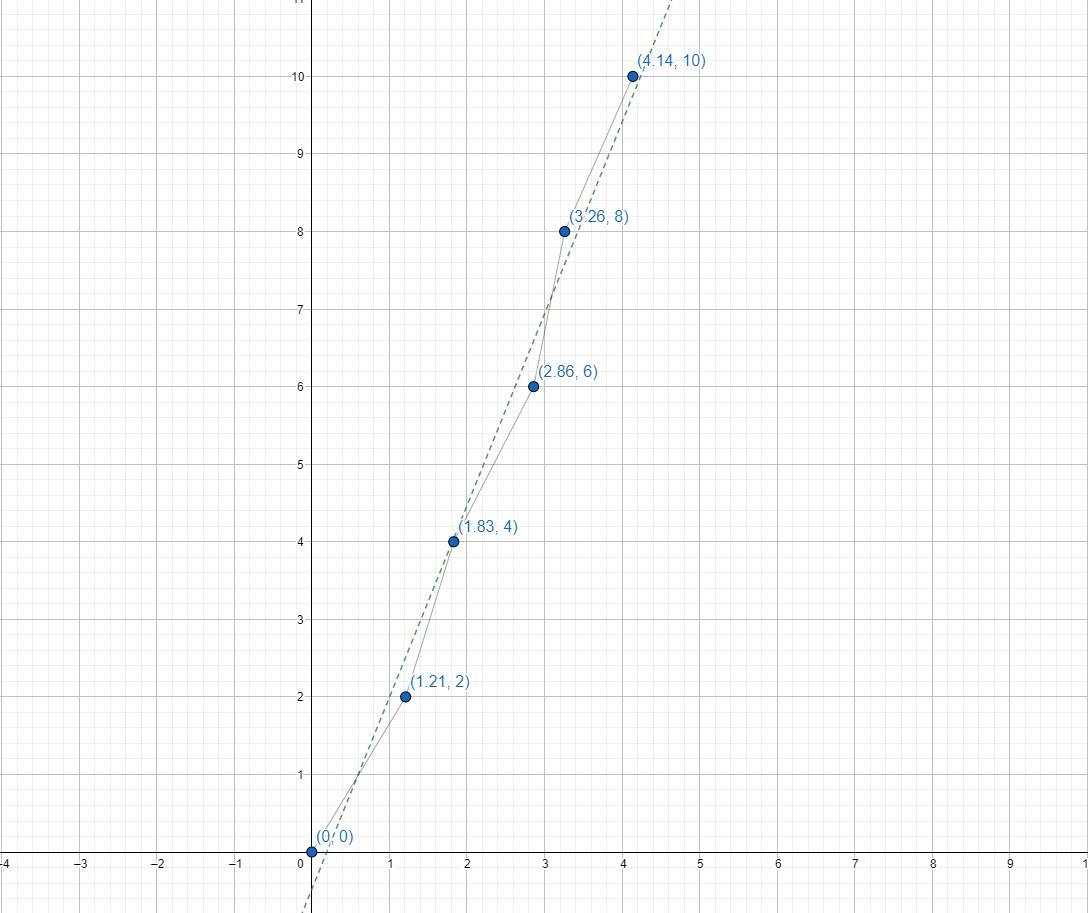
Related Questions
A popular science demonstration is to take several liquids that will not mix together and pour them in a tall glass cylinder so as to stack them one on top of the other. A teacher places vinegar, motor oil and corn syrup were placed in the same tall narrow glass cylinder. Explain what you would expect to se in the glass cylinder provided for you below. Briefly explain why you expect to see these results.
Answers
What we expect to observe in the glass is that the given liquids are placed in the following order from bottom to the top:
Corn syrup
Vinegar
Motor oil
The previous order is fue to the fact that substances with lower density float on substances with higher density. Substance with higher density have more mass per unit of volume and the force of gravity is greater over substan.
A model of a helicopter rotor has four blades, each 2.60 m long from the central shaft to the bladetip. The model is rotated in a wind tunnel at 477 rev/min. What is the radial acceleration of theblade tip expressed as a multiple of g?Answer:Choose...Next page
Answers
The radial acceleration in terms of the frequency and the radius is given by:
[tex]a_c=4\pi^2rf^2[/tex]To use this formula we need to convert the frequency to revolution per second:
[tex]477\frac{rev}{\min}\cdot\frac{1\text{ min}}{60\text{ s}}=7.95\text{ Hz}[/tex]Plugging the values we have:
[tex]\begin{gathered} a_c=4\pi^2(2.6)(7.95)^2 \\ a_c=6487.35 \end{gathered}[/tex]hence the acceleration is 6487.35 m/s^2. To get the acceleration in terms of g we divide it by its value:
[tex]\begin{gathered} a_c=\frac{6487.35}{9.8} \\ a_c=661.97 \end{gathered}[/tex]This means that the acceleration is approximately 662 times the acceleration of gravity, that is:
[tex]a_c=662g[/tex]Pls help. If you cannot see the directions, the directions are: Use the images below to determine whether a substance is a Pure Substance, Mixture, Element, Compound, Mixture of Elements, Mixture of Compounds, or Mixture of both Elements and Compounds.
Answers
The classifications of the substances are;
Compound
1,2,3
Mixture
4,5,6
Pure substances
1,7,8
Elements and compounds
1
What is a mixture?The term mixture has to do with a substances that is obtained by a combination of two or more substances that are not chemically combined together. We know that on the other hand a compound is formed when there is a combination of elements that are chemically combined together.
When we talk of a pure substances, we are talking of the substances that are composed of only one kind of material. There are also some compounds that we may call compound elements. These are the compounds that are composed of only one kind of element.
The elements and the compounds are pure substances in the sense that they are composed of only one type of material.
Learn more about mixtures:https://brainly.com/question/24898889
#SPJ1
A 62.7 kg astronaut is holding a 6.5 kg tool pack while drifting at 12.3 m/s to the right. She throws the tool pack away so thatit is drifting at 2.4 m/s to the left. How fast is she moving after the throw? Assume that they are out in deep space with noother forces acting on them.
Answers
Answer:
[tex]v_{new}=9.9ms^{-1}[/tex]Explanation: Assuming that it took one second to throw the tool away, then we have to use the final velocity formula to get the new velocity:
[tex]v(t)=v_o+at[/tex]One second would imply that the deceleration in the initial astronaut velocity is:
[tex]\begin{gathered} a=-2.4ms^{-2} \\ \end{gathered}[/tex]Note the sign convention!
The new velocity of the astronaut after the throw would be now:
[tex]\begin{gathered} t=1s \\ \therefore\Rightarrow \\ v(1s)=12.3ms^{-1}+(-2.4ms^{-2})(1s)=(12.3-2.4)ms^{-1} \\ v_{new}=9.9ms^{-1} \end{gathered}[/tex]Solve the inequality for x. Show each step of the solution.10x>9(2x-8)-20
Answers
Given,
[tex]10x>9(2x-8)-20[/tex]On simplifying the above equation,
[tex]\begin{gathered} 10x>18x-72-20 \\ \Rightarrow10x>18x-92 \\ \Rightarrow10x-18x>-92 \\ \Rightarrow-8x>-92 \end{gathered}[/tex]On further simplifying,
[tex]\begin{gathered} 8x>92 \\ \Rightarrow x>\frac{92}{8} \\ \Rightarrow x>11.5 \end{gathered}[/tex]Thus on solving the given inequality, we get, x>11.5
In a reactor, if power is lost what lowers the control rods into the core to shut it down? Select one:a.hydraulicsb.peoplec.robotsd.gravity
Answers
Given:
The power is lost in a reactor
To find:
What lowers the control rods into the core to shut it down
Explanation:
Control rods are important safety features of reactors as they allow the user to control the output of the reactor. The control rods are held by electromagnetic fields.
If there is some sort of power failure or loss of signal the control rods are immediately released and fall into the reactor core because of gravity.
Hence, the correct option is gravity.
5. Law of Acceleration: A 1400 kg car is initially at rest. It is then accelerated by a 3000 N force for 10 seconds.What is the car's acceleration?How fast is it going after 10 seconds?
Answers
The force acting on the car can be expressed as,
[tex]F=ma[/tex]Plug in the known values,
[tex]\begin{gathered} 3000\text{ N=(1400 kg)a} \\ a=\frac{3000\text{ N}}{1400\text{ kg}}(\frac{1kgm/s^2}{1\text{ N}}) \\ =2.14m/s^2 \end{gathered}[/tex]Thus, the acceleration of the car is 2.14 m/s2.
The final velocity of the car is given as,
[tex]v=u+at[/tex]Substitute the known values,
[tex]\begin{gathered} v=0m/s+(2.14m/s^2)(10\text{ s)} \\ =21.4\text{ m/s} \end{gathered}[/tex]Thus, the final velocity of the car is 21.4 m/s.
How do I find the force he uses to throw backwards
Answers
Remember that the average force F exerted over an object equals the change in the linear momentum of that object divided by the time over which the force is exerted:
[tex]F=\frac{\Delta p}{\Delta t}[/tex]Assume that the direction towards Superman is negative and the direction away from Superman is positive. Find the initial and final linear momentum of General Zod, then calculate the change in the linear momentum and divide it by 1.5 seconds to find the average force exerted by Superman.
The linear momentum p of an object with mass m and speed v is given by:
[tex]p=mv[/tex]The mass of General Zod is 150kg. Its initial speed is 25 m/s towards Superman. Then, its initial velocity is negative and its initial linear momentum is:
[tex]\begin{gathered} p_0=150\operatorname{kg}\times-25\frac{m}{s} \\ =-3750\operatorname{kg}\cdot\frac{m}{s} \end{gathered}[/tex]The final speed of General Zod is 20 m/s away from Superman. Then, its final linear momentum is:
[tex]\begin{gathered} p_f=150\operatorname{kg}\times20\frac{m}{s} \\ =3000\operatorname{kg}\cdot\frac{m}{s} \end{gathered}[/tex]The change in the linear momentum of General Zod is:
[tex]\begin{gathered} \Delta p=p_f-p_0_{} \\ =3000\operatorname{kg}\cdot\frac{m}{s}-(-3750kg\cdot\frac{m}{s}) \\ =3000\operatorname{kg}\cdot\frac{m}{s}+3750kg\cdot\frac{m}{s} \\ =6750\operatorname{kg}\cdot\frac{m}{s} \end{gathered}[/tex]Substitute Δp=6750 kg*m/s and Δt=1.5 s to find the force exerted by Superman:
[tex]F=\frac{\Delta p}{\Delta t}=\frac{6750\operatorname{kg}\cdot\frac{m}{s}}{1.5s}=4500N[/tex]Therefore, the correct choice is option b) 4500 N.
determine the distance that light travels in a year.How long does it take light to travel 10 km? how long does it take sound to travel 10 km? How long does it take light to travel from the moon to earth?
Answers
The speed of light is equal to 300000 km/s.
Let's find how many seconds there are in a year:
1 year = 365 days = 365 * 24 hours = 365 * 24 * 60 minutes = 365 * 24 * 60 * 60 seconds
Now, multiplying this amount of time by the speed of light, we have the distance traveled by the light in one year:
distance = speed * time
distance = 300000 * 365 * 24 * 60 * 60
distance = 9,460,800,000,000 km
Now, the time needed for a distance of 10 km is:
distance = speed * time
10 = 300000 * time
time = 10/300000
time = 3.33 * 10^-5 seconds
The speed of sound is about 1225 km/h.
So, for a distance of 10 km, we have:
10 = 1225 * t
t = 10/1225
t = 0.008163265 hours
t = 29.39 seconds
The distance from moon to Earth is 384,400 km, so the time needed is:
384400 = 300000 * t
t = 384400/300000
t = 1.2813 seconds
A gymnast of mass 52.0 kg is jumping on a trampoline. She jumps so that her feet reach a maximum height of 2.98 m above the trampoline and, when she lands, her feet stretch the trampoline 70.0 cm down. How far does the trampoline stretch when she stands on it at rest? Assume that the trampoline is described by Hooke’s law when it is stretched.
Answers
When the gymnast is at 2.98 meters above the trampoline, she has potential gravitational energy in relation to the trampoline:
[tex]\begin{gathered} PE_g=m\cdot g\cdot h \\ PE_g=52\cdot9.81\cdot2.98 \\ PE_g=1520.16\text{ J} \end{gathered}[/tex]When she lands on the trampoline, all this energy will be converted into potential elastic energy:
[tex]\begin{gathered} PE_e=\frac{kx^2}{2} \\ 1520.16=\frac{k\cdot0.7^2}{2} \\ 0.49k=3040.32 \\ k=6204.73\text{ N/m} \end{gathered}[/tex]Now, to find the stretch in the trampoline when the gymnast is at rest, let's use the gymnast weight force in the formula for the force in a string:
[tex]\begin{gathered} F=k\cdot x \\ m\cdot g=k\cdot x \\ 52\cdot9.81=6204.73\cdot x \\ 510.12=6204.73 \\ x=\frac{510.12}{6204.73} \\ x=0.0822\text{ m} \end{gathered}[/tex]Therefore the trampoline stretches 8.22 cm.
A 87 kg person sits at rest at the top of a 51m high amusement park ride. How much energy does the person have at this point
Answers
We will calculate potential energy, in this case, using the next formula
[tex]PE=\text{mgh}[/tex]where m is the mass, g is the gravity and h is the height
in our case
m=87 kg
g=9.8 m/s^2
h=51m
we substitute
[tex]PE=87(9.8)(51)=43482.6J[/tex]ANSWER
The energy is 43482.6J
You and your friend are trying to push a table into a corner. You push with a force of 50 N towards towards one wall while your friend pushes at right angle towards the other wall with a force of 60 N. What is the combined force on you and your friend on the table and in which direction will it move?
Answers
The combined force on the table is 110N towards the other wall your friend pushing at.
What is net force?Objects at rest tend to stay at rest, and objects in motion tend to continue to move at the same speed and in the same direction, unless an imbalanced force is applied.
Newton's first law states: , an unbalanced force refers to a force that is not completely balanced (or canceled) by other individual forces. Unbalanced forces exist when all vertical forces (up and down) do not cancel each other and/or when all horizontal forces do not cancel each other.
Net force is defined as the sum of all forces acting on a body. Net force is the term used in systems when there are a significant number of forces.
Net force = F₁ + F₂ + F₃….+ Fₙ
if the force acting differ in their angle the,
Net force = [tex]\sqrt{a^{2} + b^{2} + 2abcos}[/tex]θ
Where, a = F₁
b = F₂
θ = angle at which force exerts
For the given case:
a = 50 N
b = 60 N
θ = 90°
cos90 = 0
So, Net force (Fₙ) = [tex]\sqrt{a^{2} + b^{2}[/tex]
Fₙ = 50 N + 60 N
Fₙ = 110N
To know more about net force visit:
https://brainly.com/question/15711576
#SPJ1
selasieKOPsBunPANTOPERE. O 11.18 m, 148.435 deg14. Given the vectors A = 50 m 10 degnorth of east and B = 100 m 80 deg south of west,find the x and y components of their sum vector A + B. (1 point)A. O(31.876 m, -89.798 m)B. (18.694 m, -130.237 m)C. O(6.913 m. -76.906 m)D. O(6.913 m, -89.798 m)E. O(31.876 m. -76.906 m)70.50
Answers
Given:
The vector A is 50 m 10 deg north of east.
The vector B is 100 m 80 deg south of west.
To find the x and y components of their sum vector A+B
Explanation:
The vectors can be represented in diagram as shown below
The x-component can be calculated as
[tex]\begin{gathered} A_x+B_x=\text{ 50 cos \lparen10}^{\circ}\text{\rparen-100 cos\lparen80}^{\circ}\text{\rparen} \\ =\text{ 31.876 m} \end{gathered}[/tex]The y-component can be calculated as
[tex]\begin{gathered} A_y+B_y=50sin(10^{\circ})-100sin(80^{\circ}) \\ =-89.798 \end{gathered}[/tex]Thus, option A is correct.
If you throw a 0.3 kg ball straight up with an initial speed of 32 m/s, how fast will it be moving when it’s 20 m above the release point? Round your answer to the nearest tenth and include the appropriate unit.
Answers
Given:
The mass of the ball, m=0.3 kg
The initial speed of the ball, u=32 m/s
The height, h=20 m
To find:
The speed of the ball when it is at a height of 20 m.
Explanation:
The ball will be moving under the influence of acceleration due to gravity which is directed downwards.
From the equation of motion,
[tex]v^2=u^2-2gh[/tex]Where v is the final velocity of the ball and g is the acceleration due to gravity.
On substituting the known values,
[tex]\begin{gathered} v^2=32^2-2\times9.8\times20 \\ \implies v=\sqrt{32^2-2\times9.8\times20} \\ =25.1\text{ m/s} \end{gathered}[/tex]Final answer:
The velocity of the ball when it is 20 m above the releasing point is 25.1 m/s
The pressure at the bottom of a jug filled with water does NOT depend on the
__________.
A) depth of the liquid
B) acceleration due to gravity
C) density of water
D) surface area of the water
E) none of the above
Answers
Answer:
D
Explanation:
because of the the side of the bottom
A pelican flying along a horizontal path drops
a fish from a height of 5.0 m. The fish travels
8.5 m horizontally before it hits the water
below.
What was the pelican’s initial speed? The
acceleration of gravity is 9.81 m/s^2
Answer in units of m/s.
Answers
The initial velocity of the pelican, given that it dropped a fish from a height of 5.0 m is 8.5 m/s
How do I determine the initial velocity of the pelican?We'll begin by obtaining the time taken for the fish to hit the water. This can be obtained as follow:
Height (h) = 5.0 mAcceleration due to gravity (g) = 9.81 m/s²Time (t) =?h = ½gt²
5 = ½ × 9.81 × t²
5 = 4.905 × t²
Divide both side by 4.905
t² = 5 / 4.905
Take the square root of both side
t = √(5 / 4.905)
t = 1 second
Finally, we shall determine the initial velocity of the pelican. Detail below:
Horizontal distance (s) = 8.5 mTime (t) = 1 secondInitial velocity of pelican (u) = ?s = ut
8.5 = u × 1
u = 8.5 m/s
Thus, we can conclude that the initial velocity is 8.5 m/s
Learn more about velocity:
https://brainly.com/question/21010554
#SPJ1
Which is MOST responsible for Earth’s seasons?
A.tilt of the Earth on it’s axis
B.The effect of mountains and large bodies of water
C.Earth’s changing distance to the moon
D.Earth’s changing distance from the sun
Answers
The MOST responsible for Earth’s seasons is A. tilt of the Earth on it’s axis
A season is a period of the year that is distinguished by special climate conditions. The four seasons are spring, summer, fall, and winter Earth's axis of rotation is tilted 23.4 degrees with respect to the plane of Earth's orbit around the Sun. This tilt causes our yearly cycle of seasons
When the earth's axis points towards the sun, for that hemisphere there will be summer and When the earth's axis points away there will be winter for that hemisphere .
hence , correct answer will be
A. tilt of the Earth on it’s axis
To learn more about earth's axis here
https://brainly.com/question/11782583
#SPJ1
what is the centeipital force of a 0.2 kg ball traveling in a circle with a radius of 1 m if it completes one revolution every secondanswer is in meters per second squared
Answers
The mass of the ball, m = 0.2 kg
Radius of the circle, r = 1 m
To convert the angular speed to rad per second from revolution per second, multiply by 2π
w = 1 rev/sec = 2π rad/sec
The velocity, v = wr
v = (2π) x 1
v = 2π m/s
The centripetal force is given by the formula:
[tex]\begin{gathered} F\text{ = }\frac{mv^2}{r} \\ F\text{ = }\frac{0.2\times(2\pi)^2}{1} \\ F\text{ = 0.2 }\times\text{ 4}\pi^2 \\ F\text{ = 0.8}\pi^2 \\ F=0.8(3.142)^2 \\ F\text{ = 7.9 N} \end{gathered}[/tex]The centripetal acceleration is given as:
[tex]\begin{gathered} a\text{ = }\frac{v^2}{r} \\ a\text{ = }\frac{(2\pi)^2}{1} \\ a\text{ = 4}\pi^2 \\ a=4(3.142)^2 \\ a\text{ = }39.49m/s^2 \end{gathered}[/tex]A sled and rider with a combined weight of 70.0 kg are at rest on the top of a hill 11.0 m high. (Enter your answers in J.) Assuming there is no friction, what would the total energy be on sliding halfway down the hill?answer with:___ J
Answers
We know that at the top of the 11 m hill the sled and rider are at rest, which means that all the energy at this point is potential energy; the potential energy is given by:
[tex]U=mgh[/tex]Plugging the values given we have:
[tex]\begin{gathered} U=(70)(9.8)(11) \\ U=7546 \end{gathered}[/tex]Hence at the top of the hill the total energy is 7546 J.
Now, from conservation of energy and since there is no friction, we know that at any point of the motion the total energy is the same as the starting energy.
Therefore, the total energy halfway the hill is 7546 J.
Note: At this point we would expect the potential energy to be half of what it was at the top of the hill and the other half will be kinetic energy; nonetheless the total energy, which is the sum of the kinetic and potential energy, has to remain the same as the initial energy.
A proton traveling vertically upward (out of the page) experiences a magnetic force directed North. The direction of the magnetic field is_________.Group of answer choicesdown (into the page)SouthEastWest
Answers
To find:
The direction of the magnetic force.
Explanation:
The direction of the magnetic field or a magnetic force on a charged particle is given by the right-hand rule. It states that when the thumb, middle finger, and index finger are held in such a way that they are perpendicular to each other if the thumb is pointing in the direction of the positive charge and the middle finger is pointing in the direction of the magnetic force then the index finger will point in the direction of the magnetic field.
Thus applying this rule we find that the index finger will be pointing to the east.
Final answer:
Thus the direction of the magnetic field is east.
If a microwave is determined to use 840 W of power on a 120 V circuit, how many amperes does it need to run?
Answers
ANSWER:
7 amperes
STEP-BY-STEP EXPLANATION:
Given:
Power (P) = 840 W
Voltage (V) = 120 V
We can calculate the current value as follows:
[tex]\begin{gathered} I=\frac{P}{E} \\ \\ \text{ We replacing:} \\ \\ I=\frac{840}{120} \\ \\ I=7\text{ A} \end{gathered}[/tex]Therefore, the number of amperes is 7
Which statement best describes the gravitational force of an object? (1 point)
O The object only has gravitational force when it is on the surface of a massive body, such as Earth.
O The farther away an object is, the greater its gravitational force will be.
O The greater the object's mass and the closer it is, the greater its gravitational force.
O The greater the object's mass, the less its gravitational force will be.
Answers
The attraction created by gravity is between masses. The gravitational force increases as the mass of an object increases (also called the gravity force). With an increase in the distance between masses, the gravitational pull rapidly lessens.
The gravitational force is the force that exists between two bodies regardless of whether there are any other objects in their path. Its formula isF=GMm/R²
Where, R is the object's distance from the center of the Earth and G is the gravitational constant ,M is mass of earth and m is the mass of the object.
Weight is the term for the gravitational pull that the earth has on an object. It is also equal to the product of acceleration due to gravity and mass of the object.Weight = mg, where m is an object's mass and g is its acceleration due to gravity .
T o know more about gravitational force
https://brainly.com/question/28596644
#SPJ1
Answer:
The greater the object's mass and the closer it is, the greater the gravitational force will be.
Explanation:
im taking the test and found the answer on questions.llc, another helpful and usually reliable site
Part 2/2 please.The answer to Part 1/2 is 4.5 m
Answers
In order to calculate the wave speed, we can use the formula below:
[tex]v=\lambda f[/tex]Where lambda is the wavelength and f is the frequency.
If the wavelength is 4.5 meters and the frequency is 3 Hz, the speed is:
[tex]v=4.5\cdot3=13.5\text{ m/s}[/tex]104 km = _______ mUsing the ladder method
Answers
1 km=1000 m
Therefore,
[tex]\begin{gathered} 104\text{ km=(104 km)(1000m/1 km)} \\ =104000\text{ m} \end{gathered}[/tex]A ramp outside a building is 8 m long. One end of the ramp is 2 m higher thanthe other end. What is the mechanical advantage of the ramp?A. 4B. 6C. 1/4D. 1/8
Answers
Given that the slope of the ramp is L = 8 m
The height of the ramp is h = 2 m
We need to calculate the mechanical advantage of the ramp.
The mechanical advantage of the ramp can be calculated by the formula
[tex]\text{Mechanical advantage =}\frac{L}{h}[/tex]Substituting the values, the mechanical advantage will be
[tex]\begin{gathered} \text{Mechanical advantage =}\frac{8}{2} \\ =4\text{ } \end{gathered}[/tex]Thus, the correct option is A. 4
Find the equivalent resistance of thiscircuit.R₁www400 ΩIR₂600 ΩReq = [?] 2R3www500 Ω
Answers
We are given the following information.
Resistor: R₁ = 400 Ω
Resistor: R₂ = 600 Ω
Resistor: R₃ = 500 Ω
We are asked to find the equivalent resistance of the given circuit.
Notice that the resistors R₁ and R₂ are in parallel and this parallel combination is in series with resistor R₃.
First, let us find the parallel resistance of R₁ and R₂.
[tex]R_p=\frac{R_1\times R_2}{R_1+R_2}=\frac{400\times600}{400+600}=\frac{240000}{1000}=240\;\Omega[/tex]Finally, let us find the series resistance of Rp and R₃.
[tex]\begin{gathered} R_{eq}=R_p+R_3 \\ R_{eq}=240+500 \\ R_{eq}=740\;\Omega \end{gathered}[/tex]Therefore, the equivalent resistance of the given circuit is 740 Ω.
I need help answering these questions using my experiment results. I will send you the results
Answers
Answer:
(a) It changed
(b) It changed
(c) It changed
(d) It changed
Explanation:
For each parameter, we get:
(a) the final velocity of the ball.
The velocity is equal to the distance over time. Since the distance is always 10 m, the velocity will depend on the time. So, when the time is greater, the final velocity is smaller.
In this case, we can see that for each angle, we get different times, so, the angle affects the final velocity of the ball.
(b) work
The work can be calculated as:
W = Fdcosθ
Where F is the force, d is the distance and θ is the angle between them. When we change the angle of the incline, we affect the angle of the Force and the displacement, so the work changes.
(c) initial potential energy
The potential energy depends on the initial height, if the height is greater, the potential energy is greater. So, when the angle of the incline change, the height change, so the potential energy change
(d) final kinetic energy
The kinetic energy depends on the final velocity, if the final velocity is greater, the kinetic energy is greater. Since the final velocity changes with the angle, the kinetic energy also changes with the angle.
i need help with this because my teacher wont help me
Answers
Given:
The speed of the signal is v = 1500 m/s
The time is t = 1.5 s
To find the distance traveled by signal.
Explanation:
The distance traveled by signal can be calculated by the formula
[tex]d=\frac{v\times t}{2}[/tex]On substituting the values, the distance traveled will be
[tex]\begin{gathered} d\text{ = }\frac{1500\times1.5}{2} \\ =\text{ 1125 m} \end{gathered}[/tex]Thus, the distance traveled by the signal is 1125 m
A) show the forces acting on the block in a labelled sketch when the surface is tilted. Treat the cylinder as a point.B) what is the maximum angle the rough surface can make with the horizontal before the cylinder topples over give answer to nearest degree
Answers
Given:
Diameter, d = 20 cm
Height, h = 40 cm
Mass, m = 10 kg
Given that the surface is slowly inclined to the horizontal, let's find the following:
• (A) Show the forces acting on the block in a labelled sketch when the surface is tilted. Treat the cylinder as a point.
The forces acting on the block are sketched below:
• (B) What is the maximum angle the rough surface can make with the horizontal before the cylinder topples over give answer to nearest degree.
The normal force (N) = 0 at the time the cylinder topples.
Before the the cylinder topples, tnet = 0
Apply the formula:
[tex]mg\sin \theta\ast\frac{h}{2}-mg\cos \theta\ast\frac{d}{2}=0[/tex]Rewrite the equation for θ:
[tex]\begin{gathered} \sin \theta h=\cos \theta d \\ \\ \frac{\sin\theta}{\cos\theta}=\frac{d}{h} \\ \\ \tan \theta=\frac{d}{h} \\ \\ \theta=\tan ^{-1}(\frac{d}{h}) \end{gathered}[/tex]Where:
d = 20 cm
h = 40 cm
We have:
[tex]\begin{gathered} \theta=\tan ^{-1}(\frac{20}{40}) \\ \\ \theta=\tan ^{-1}(0.5) \\ \\ \theta=26.57\approx27^0 \end{gathered}[/tex]Therefore, the maximum angle the rough surface can make with the horizontal before the cylinder topples over is approximately 27 degrees.
Find the capacitance of a parallel-plate capacitor made of two 4.0 cm x 4.0 cm metal plates if the plates are separated by 5.0 mm.Group of answer choices2.8x10-10 F1.0x10-6 F2.8x10-12 F2.0x10-5 F
Answers
Given the area is:
A=4.0 cmx4.0 cm
The seperation distance is d=5.0 mm
The capacitance is :
[tex]\begin{gathered} C=\frac{\epsilon_oA}{d} \\ \Rightarrow C=8.85\times10^{-12}\frac{4.0\times10^{-2}\times4.0\times10^{-2}}{5\times10^{-3}} \\ \Rightarrow C=2.83\times10^{-12}F \end{gathered}[/tex]Thus the answer is
[tex]2.8\times10^{-12}F[/tex]